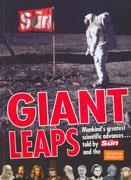James Berressem reviews this engaging text
Giant leaps: Mankind's greatest scientific advances... told by the Sun and the Science Museum
Jack Challoner and John Perry
London: Pan Macmillan 2006 | Pp144 | £12.99 | ISBN 0 752 22624 X

This coffee-table style book presents the science behind the most important discoveries that have shaped our understanding of the universe and continue to influence our everyday lives. A collaboration between the Sun and the Science Museum, the book uses a novel approach which is fun, informative and engaging.
In chronological order, starting with the Big Bang 14 million years ago, the text covers 61 scientific discoveries, including a few breakthroughs which later generations might one day witness. Achievements covered which relate to chemistry include the smelting of iron, the production of gunpowder and the synthesis of plastics.
Each discovery is presented in double-page spread, though six characters and discoveries are given an additional two-page spread (Leonardo da Vinci, Isaac Newton, steam engines and railways, powered flight, the golden age of great invention and space exploration). The right-hand page of each spread, written by the Sun journalist John Perry, shows each scientific achievement as if they were front-page stories in the newspaper. Designed to entertain, these pages look authentic and are fun to read with headlines such as 'Flask tango in Paris. Sex scandal of Nobel winner Marie and married scientist'. I particularly liked the reporters names, eg Heath Rowe and Stan Stead who cover the Wright Brothers' powered flight.
Each Sun 'splash' is accompanied by a page that provides information on the science and scientists behind each discovery. Written by the Science Museum's Jack Challoner, these pages put each discovery into its historical context and highlight its impact on the development of science and technology and the world in general. The information is concise and clear. However, the level of detail is limited in places by the single-page format, for example what were the gases Urey and Miller included in their experimental atmosphere? But such omissions might serve as opportunities for class discussion to investigate further the concepts presented. All the pages are illustrated with excellent photos, which are accompanied by informative captions.
This is ideal material to dip into when you have a spare moment. But more extended reading is encouraged by cross references to other pages. For example, once you've learnt about the printing press a 'Now Jump to' box directs you to other pages on photography and the Internet.
This is an enjoyable read which will enthuse readers of all ages about science. Priced at £12.99, teachers would do well to buy their own copy. It may prove a valuable resource to use when introducing new topics in science and to support the teaching of the 'how science works' element of the science curriculum.






No comments yet